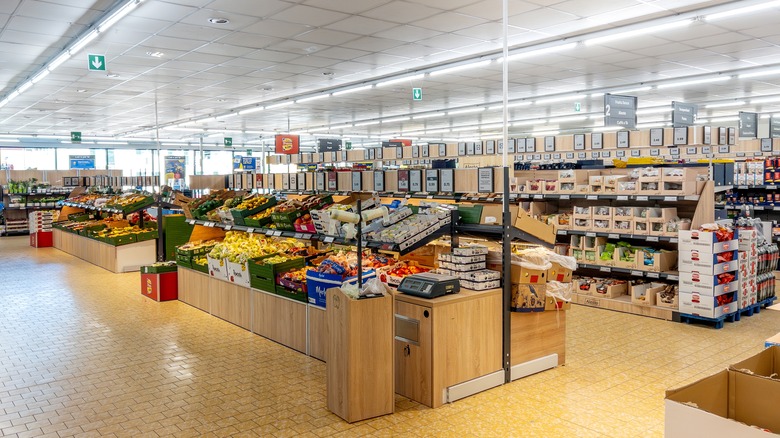Aldi Vs Lidl: The Differences You Need To Know Before Checkout
On the surface, the two grocery stores might look much the same. They both have German origins, similar four-letter names, and even have comparably bright yellow, red, and blue branding. Discount products all sit on modest, unadorned shelving. But if you're a frequent Aldi shopper and find yourself crossing the threshold of a Lidl (or vice versa), you might notice that the similarities mostly end with the basic concept.
And the dissimilarities begin with the big picture, as Aldi is much more plentiful in the United States than Lidl. Aldi started in the 1960s in Germany and opened its first U.S. store in 1976. Now, its more than 2,400 U.S. locations are found in 38 different states. Around the same time that Aldi was establishing its U.S. brand, Lidl was opening its first store in Ludwigshafen, Germany. Over the next few decades, it would expand operations to 31 countries around the world, but its first U.S. store only opened in 2017, and its footprint remains fairly small. Lidl has only 180 stores in the country, all confined to the East Coast.
Especially if you're in a smaller town or living too far west of the Eastern Seaboard, the decision between the two brands might be made for you as Aldi might be your only option. But if you happen to have both retailers in your neighborhood, you'll find that there are a lot of differences beyond the front doors.
Chalk it up to shopping experience
Truthfully, the differences start before you even get inside. Frequent Aldi shoppers know that the store's grocery carts require you to temporarily insert a quarter into a slot to use them (reportedly to avoid having to assign staff to cart collection), but Lidl's carts come without the impermanent price.
When you steer that cart into the store, you might also notice a few differences in the layout. Both stores sell products in the original boxes to cut down on labor around stocking, so you'll see stacks of those cardboard containers along each aisle. However, Lidl frequently throws in additional sections that change its configuration. Around 75 of its U.S. stores feature an outdoor garden center, and all Lidl stores include a bakery that sells fresh baked goods. Although Aldi does sell bread and pastries, only a few locations have a bakery. and most stores don't make baked goods in-house.
Even after you've navigated the shipping box shelves, the way that Aldi and Lidl checks you out will vary. Lidl's process will probably be familiar — the cashier scans items and moves them to a bagging area. Neither store offers plastic bags, requiring customers to bring their own reusable bags or buy them, and both stores expect you to bag your own groceries. But while the Lidl cashiers have you bag as you go, the Aldi cashier will place each scanned item back into a cart and have you bag after checkout on a special counter area off to the side. (Which you might appreciate, since Aldi employees are known for their lightning-fast grocery scanning.)
In your bags and on your bill
Inside your reusable bags, you'll find the essential meats and seafood, snacks and frozen food, household products, alcohol, and cheeses, but you might not find familiar brands. Lidl stocks its shelves with around 80% private label products, and Aldi is even more in-house, with around 90% of its products featuring a private label. While they do keep the amount and type of items limited, each store does feature its own unique product flourishes, like the infamous Aldi Finds aisle (sometimes referred to as the aisle of shame) of specialty, limited-time-only merchandise, including candles, cookware, and garden gnomes galore, or Lidl's wine labeling that's color coded for flavor profile.
Many of the retailers' choices are made to cut costs, including the scarcity of name brands and private labels selling for sometimes as much as 50% less than a brand name equivalent, and lots of lists of the cheapest grocery stores in America have the two competing for top spots in affordability. Although prices on specific products will vary and the two chains are quite close in prices, Aldi generally has the cheaper choices. But Lidl accepts coupons, while Aldi doesn't take them. The retailers are often neck-and-neck in terms of products and prices, but if you're an avid coupon clipper, pastry connoisseur, budget buyer, or aisle adventurer, you'll know you have to make a decision between Aldi and Lidl.


